Research - (2020) Advances in Dental Surgery
Oral Hygiene Practices Among Jewellers in Srilanka
Ashinie C, Dhanraj Ganapathy*,* and Keerthi Sasanka
*Correspondence: Dhanraj Ganapathy*,, Department of Prosthodontics, Saveetha Dental College, Saveetha Institute of Medical and Technical Sciences, Saveetha University, Chennai, India, Email:
Abstract
Prevalence and severity of dental disease vary from individual to individual and is affected by age, gender, education, and socioeconomic status.Most oral diseases, like most chronic pathologies in general, are causally related to lifestyle.Oral hygiene maintenance is an important factor in a person’s life. It helps in maintaining durability and function of our teeth. Oral health knowledge is considered to be an essential prerequisite for health-related behavior. Sri Lanka, a country with a 22 million population, requires an awareness of oral hygiene practices to have a healthy population.The aim of the study is to know the oral hygiene practices among jewellers in Srilanka. A cross sectional survey was initiated from a randomly chosen population of 100 jewellers in Sri Lanka from different districts. Out of the 100 samples all were males. The survey was conducted online using survey planet online survey tool. The survey instrument used was a pretested questionnaire comprising 10 questions eliciting responses pertaining to the knowledge on oral hygiene practices. The data collected from these 100 jewellers then statistically analysed to generate appropriate results regarding the questionnaire study. The results show that 75% of the jewellers in Sri Lanka brush twice a day and 76% of them use floss or mouthwash other than brushing; this indicates that they follow a proper oral hygiene practice and are aware of the oral hygiene practices to be followed.The current study concludes that the jewellers in srilanka follow satisfactory oral hygiene practices.
Keywords
Oral hygiene, Jewellers, Dental check up
Introduction
Oral health is an inseparable part of general health and there are many factors that influence the oral health of an individual such as attitude, awareness, literacy, and environment [1]. Oral diseases and disorders often result in physical discomfort and pain [2]. The awareness of causative factors for oral diseases and about the oral hygiene practices also influence the oral health of a population [3]. Oral hygiene can be improved by analysing the tradition, their practices, their work and based on the environment they live in also. Specific groups of people in specific places follow different oral hygiene practices [4]. Sometimes practices like tobacco, alcohol consumption and smoking also influence their oral hygiene [5].
Many studies have been done on analysing the oral hygiene practices of people. Studies were done to know the prevalence of caries among preschool children in a district in Sri Lanka and to know how far people are aware of the healthy oral hygiene practices [6]. Studies on oral hygiene practices were also done on people belonging to different socio-economicstatus [7]. Studies were also done to investigate the oral hygiene practices of different types of people like it was done among pregnant women [8]. Many studies have been done all over the globe by many researchers to understand and assess oral health.
Even though there are many studies as cited earlier done on different groups of people of the same age, place and people with same traditional practices there are no studies done to investigate the oral hygiene practices of people doing the same job . This may also influence the oral hygiene practices as among themselves they communicate more and each one’s perception of oral hygiene practices they follow may change. In srilanka studies were done with school children and adolescents but it did not target a specific group of people doing the same job.So, this article helps us to know about the oral hygiene practices among jewellers.
Previously our department has published extensive research on various aspects of prosthetic dentistry[9–19], this vast research experience has inspired us to research about the knowledge and awareness on oral hygiene practices among jewellers in srilanka.
Materials and Methods
A cross sectional survey was initiated from a randomly chosen population of 100 jewellers in Sri Lanka from different districts. A simple random sampling technique was used to identify the samples. Informed consent was obtained from the participants and confidentiality of the records wereensured. Out of the 100 samples all were males. The survey was conducted online using survey planet online survey tool. The survey instrument used was a pretested questionnaire comprising 10 questions eliciting responses pertaining to the knowledge on oral hygiene practices. The data collected from these 100 jewellers then statistically analysed to generate appropriate results regarding the questionnaire study.
Results and Discussion
When asked about the frequency of brushing among the jewellers of Srilanka about 75% of them brush twice a day while only 23% of them brush once a day. Majority of the jewellers about 76% of them use floss or mouthwash along with brushing while only 24% of them do only brushing. When asked about frequency of changing and the tooth brush majority of them about 77% of them change their toothbrush once in three months while 13% of them change once in six months and about 8% of them change once in a year and about 2% of them do not exactly know when they change their brush but they use it for a longer time. About 94% of them visit a dental doctor only when they are in pain and only 6% of them visit a dental doctor for a regular checkup. When the jewellers were asked whether they have gone for a dental checkup 78% of them have not gone for a dental checkup and only 22% of them have gone for a checkup. When they were asked how often they think that they should visit a dental doctor for which about 77% of them said only when in pain and 14% said once in six months and 9% said once in a year. When asked about how much time they brush their teeth 43% of them said they brush teeth for 2 min, 37% of them brush for more than 2 min and 15% of them for a minute and 5% of them for a few seconds. Among 100 jewellers about 78% of them have a problem of bad odour and 22% of them do not have. They were asked how they think that they can get rid of bad odour for which 71% of them suggested rinsing the mouth with salt water, 16% suggested using mouthwash and 13% suggested rinsing the mouth with water. When they were asked whether they will encourage people to go for regular dental checkup 41% said no as they do not follow it, 33% said yes as they are going to follow it and 26% said yes as they are already following it.In the present study 75% (Figure 1) of the respondents brush twice a day, a similar study was done by Sukhvinder et al. [20] states that only 43.6% of the study participants brush twice a day. In the study 76% (Figure 2) of the respondents use mouthwash along with brushing similar study done by Bobby Paul et al. [21] only 8% of the participants use mouthwash. In the current study 77% (Figure 3) of them change their toothbrush once in three months while in a similar study done by Sukhvinder Singh Oberoi et al. [20] only 49.6% change their brush once in three months. In present study 94% (Figure 4) of them visit a dental doctor only when they are in pain and 78% (Figure 5) do not go for a regular dental checkup. A similar study done by Daljit Kapoor et al. [22] 75% of the participants visit dental doctors only when they are in problem. In present study only 14% (Figure 6) of them visit adental doctor every six months, a similar study done by Bobby Paul et al. [21] 59.3% visit dental doctors every six months. Majority of the respondents 43% (Figures 7-10) of them brush their teeth for about 2 minutes, in a similar study done by Mohammed et al. [23] 40.8% of the respondents responded that they brush for 2 minutes. Majority of 78% of the respondents do not have a problem with bad breath and about 71% of them rinse their mouth to prevent bad breath, in a similar study done by Balachandran Ashwath et al. [24] about 44.6% use rinse to prevent bad breath. In present study 33% of the participants motivate others also to go for a regular dental checkup and follow proper oral hygiene.
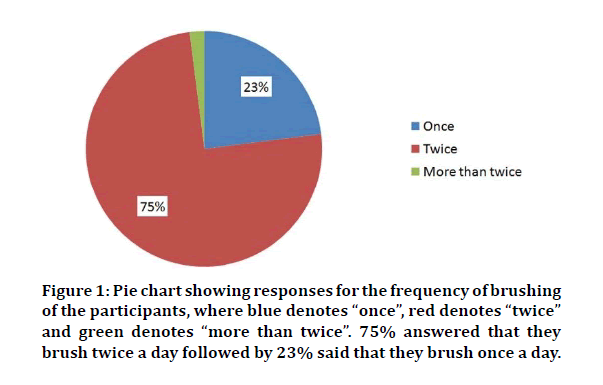
Figure 1: Pie chart showing responses for the frequency of brushing of the participants, where blue denotes “once”, red denotes “twice” and green denotes “more than twice”. 75% answered that they brush twice a day followed by 23% said that they brush once a day.
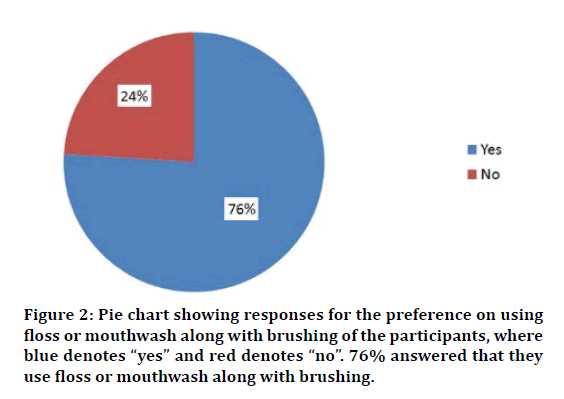
Figure 2: Pie chart showing responses for the preference on using floss or mouthwash along with brushing of the participants, where blue denotes “yes” and red denotes “no”. 76% answered that they use floss or mouthwash along with brushing.
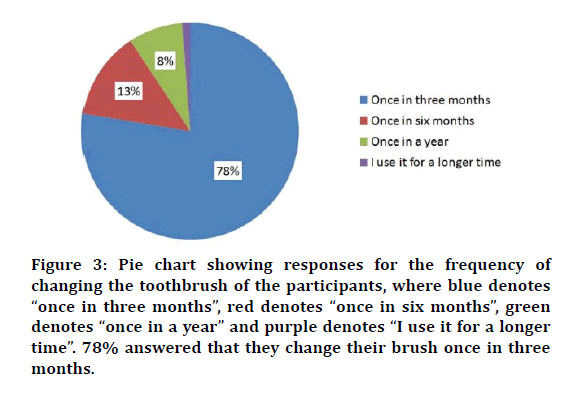
Figure 3: Pie chart showing responses for the frequency of changing the toothbrush of the participants, where blue denotes “once in three months”, red denotes “once in six months”, green denotes “once in a year” and purple denotes “I use it for a longer time”. 78% answered that they change their brush once in three months.
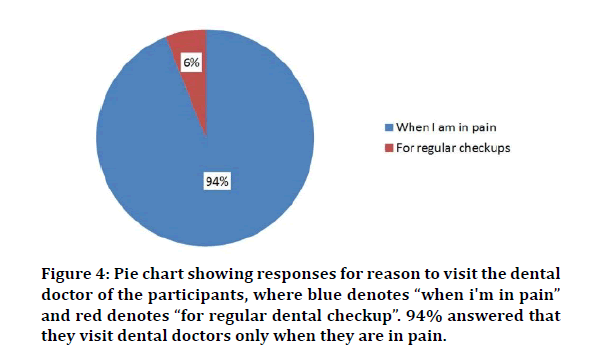
Figure 4: Pie chart showing responses for reason to visit the dental doctor of the participants, where blue denotes “when i'm in pain” and red denotes “for regular dental checkup”. 94% answered that they visit dental doctors only when they are in pain.
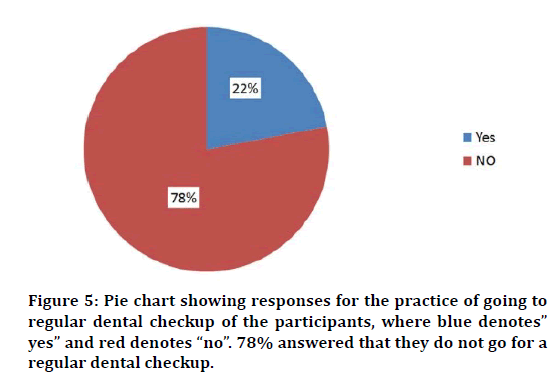
Figure 5: Pie chart showing responses for the practice of going to regular dental checkup of the participants, where blue denotes” yes” and red denotes “no”. 78% answered that they do not go for a regular dental checkup.
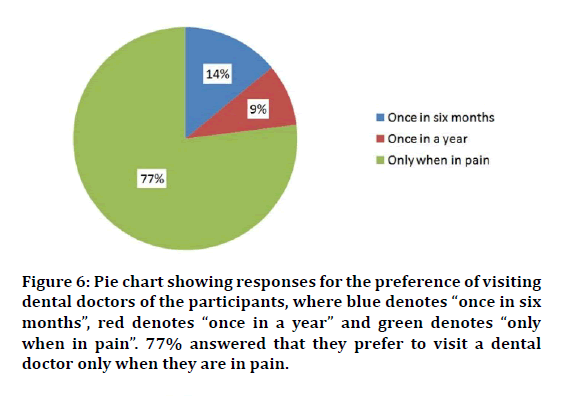
Figure 6: Pie chart showing responses for the preference of visiting dental doctors of the participants, where blue denotes “once in six months”, red denotes “once in a year” and green denotes “only when in pain”. 77% answered that they prefer to visit a dental doctor only when they are in pain.
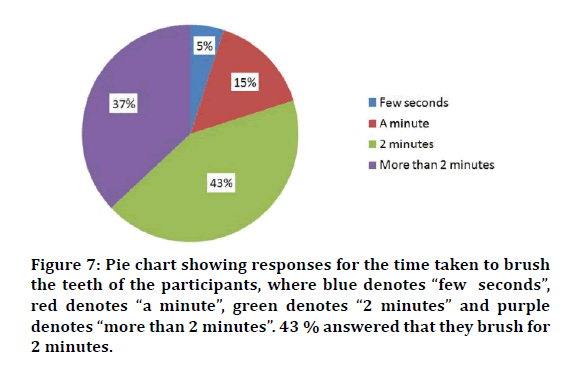
Figure 7: Pie chart showing responses for the time taken to brush the teeth of the participants, where blue denotes “few seconds”, red denotes “a minute”, green denotes “2 minutes” and purple denotes “more than 2 minutes”. 43 % answered that they brush for 2 minutes.
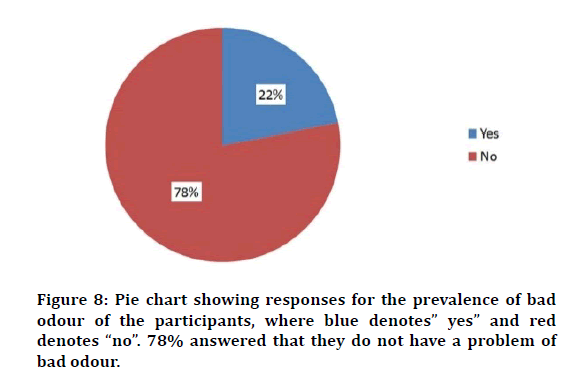
Figure 8: Pie chart showing responses for the prevalence of bad odour of the participants, where blue denotes” yes” and red denotes “no”. 78% answered that they do not have a problem of bad odour.
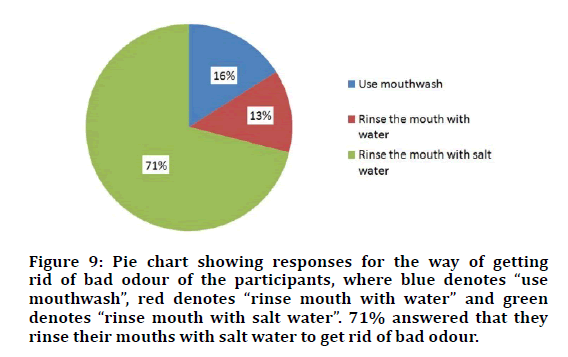
Figure 9: Pie chart showing responses for the way of getting rid of bad odour of the participants, where blue denotes “use mouthwash”, red denotes “rinse mouth with water” and green denotes “rinse mouth with salt water”. 71% answered that they rinse their mouths with salt water to get rid of bad odour.
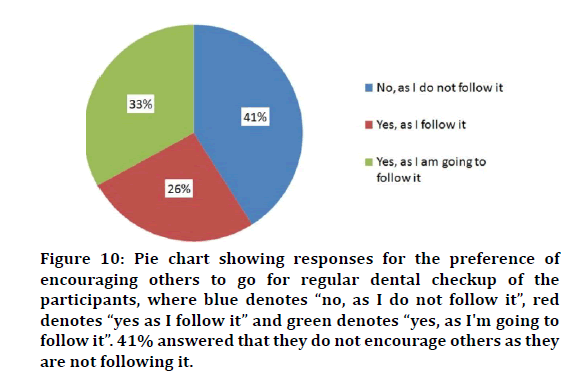
Figure 10: Pie chart showing responses for the preference of encouraging others to go for regular dental checkup of the participants, where blue denotes “no, as I do not follow it”, red denotes “yes as I follow it” and green denotes “yes, as I'm going to follow it”. 41% answered that they do not encourage others as they are not following it.
Previous studies were done among the preschool children of a district in Sri Lanka which stated that the Dental care provided for Sri Lankan preschool children appears to be unsatisfactory as prevalence of dental caries among this cohort of preschool children was very high but based on the current study the jewellers are following healthy oral hygiene practices [6]. When similar study was done on dental students in Saudi Arabia the similar results were observed and the students need to put more emphasis on oral hygiene including self-perception of healthy conditions and behaviors as they have to be healthy role models for their patients [25,26]. When the study was done on elderly people it stated that they had good oral hygiene practices, but they needed some more assistance this correlated with the results of the current study [27]. When analysing the oral hygiene practices of pregnant women of srilanka the study revealed that the women in rural areas are more prone to dental disease due to their unhealthy oral hygiene practices [28].
This study is done to know about the oral hygiene practices of jewellers in Sri Lanka.
There are only few studies done in Sri Lanka, addressing oral hygiene among people. Scientific evidence is in need to persuade authorities to establish a program promoting oral hygiene among a group of people in srilanka. The current study was done on a specific group that is a group of jewellers in srilanka. But there are many such groups in Sri Lanka whose oral hygiene practices have not been analysed and the difference between them can be compared. The oral hygiene practices of these people can differ based on their daily practices also like alcohol consumption and smoking this can be analysed in future studies.
Conclusion
This study highlights the awareness of oral hygiene practices among jewellers in srilanka. The current study concludes that the jewellers in srilanka follow proper basic oral hygiene practices. But when it comes to visiting dental doctors for checkups, they do not follow regular dental checkups. So, a little awareness is required among the jewellers of srilanka about the oral hygiene practices.
References
- Gill M, Pal K, Gambhir RS. Oral hygiene practices, attitude, and access barriers to oral health among patients visiting a rural dental college in North India. J Dent Res Review 2014; 1:114.
- Olusile AO, Adeniyi AA, Orebanjo O. Self-rated oral health status, oral health service utilization, and oral hygiene practices among adult Nigerians. BMC Oral Health 2014; 14:140.
- Shekar BRC, Reddy CVK, Manjunath BC, et al. Dental health awareness, attitude, oral health-related habits, and behaviors in relation to socio-economic factors among the municipal employees of Mysore city. Annals Tropical Med Public Health 2011; 4:99.
- Al-Otaibi M. The miswak (chewing stick) and oral health. Studies on oral hygiene practices of urban Saudi Arabians. Swed Dent J Suppl 2004; 167:2–75.
- Majmudar VP, Mishra AG, Kulkarni VS, et al. Tobacco-related knowledge, attitudes, and practices among urban low socioeconomic women in Mumbai, India. Indian J Med Paediatr Oncol 2015; 36:32–37.
- Perera PJ, Abeyweera NT, Fernando MP, et al. Prevalence of dental caries among a cohort of preschool children living in Gampaha district, Sri Lanka: A descriptive cross-sectional study. BMC Oral Health 2012; 12:49.
- Christensen LB, Petersen PE, Krustrup U, et al. Self-reported oral hygiene practices among adults in Denmark. Community Dent Health 2003; 20:229–235.
- Boggess KA, Urlaub DM, Massey KE, et al. Oral hygiene practices and dental service utilization among pregnant women. J Am Dent Assoc 2010; 141:553–561.
- Anbu RT, Suresh V, Gounder R, et al. Comparison of the efficacy of three different bone regeneration materials: An animal study. Eur J Dent 2019; 13:22–28.
- Ashok V, Ganapathy D. A geometrical method to classify face forms. J Oral Biol Craniofac Res 2019; 9:232–235.
- Ganapathy DM, Kannan A, Venugopalan S. Effect of coated surfaces influencing screw loosening in implants: A systematic review and meta-analysis. World J Dent 2017; 8:496–502.
- Jain AR. Clinical and functional outcomes of implant prostheses in fibula free flaps. World J Dent 2017; 8:171–176.
- Ariga P, Nallaswamy D, Jain AR, et al. Determination of correlation of width of maxillary anterior teeth using extraoral and intraoral factors in indian population: A systematic review. World J Dent 2018; 9:68–75.
- BegumR, Ariga P, Jain AR. Evaluation of corrosive behavior of four nickel–chromium alloys in artificial saliva by cyclic polarization test: An in vitro study. World J Dent 2017; 8:477–482.
- Ranganathan H, Ganapathy DM, Jain AR. Cervical and incisal marginal discrepancy in ceramic laminate veneering materials: A SEM analysis. Contemp Clin Dent 2017; 8:272–278.
- Jain AR. Prevalence of partial edentulousness and treatment needs in rural population of south India. World J Dent 2017; 8:213–217.
- Duraisamy R, Krishnan CS, Ramasubramanian H, et al. Compatibility of nonoriginal abutments with implants: Evaluation of microgap at the implant-abutment interface, with original and nonoriginal abutments. Implant Dent 2019; 28:289–295.
- Gupta P, Ariga P, Deogade SC. Effect of monopoly-coating agent on the surface roughness of a tissue conditioner subjected to cleansing and disinfection: A contact profilometric study. Contemp Clin Dent 2018; 9:S122–126.
- Varghese SS, Ramesh A, Veeraiyan DN. Blended module-based teaching in biostatistics and research methodology: A retrospective study with postgraduate dental students. J Dent Educ 2019; 83:445–450.
- Oberoi SS, Mohanty V, Mahajan A, et al. Evaluating awareness regarding oral hygiene practices and exploring gender differences among patients attending for oral prophylaxis. J Indian Soc Periodontol 2014; 18:369–374.
- Paul B, Basu M, Dutta S, et al. Awareness and practices of oral hygiene and its relation to sociodemographic factors among patients attending the general outpatient department in a tertiary care hospital of Kolkata, India. J Family Med Prim Care 2014; 3:107–111.
- Kapoor D, Gill S, Singh A, et al. Oral hygiene awareness and practice amongst patients visiting the department of periodontology at a dental college and hospital in North India. Indian J Dent Res 2014; 5:64–68.
- Ahad M, Gheena S. Awareness of tooth brushing techniques and proper oral hygiene among school children. Res J Pharm Biol Chem Sci 2015; 7:367.
- Ashwath B, Vijayalakshmi R, Malini S. Self-perceived halitosis and oral hygiene habits among undergraduate dental students. J Indian Soc Periodontol 2014; 18:357–360.
- Jain N, Mitra D, Ashok KP, et al. Oral hygiene-awareness and practice among patients attending OPD at vyas dental college and hospital, Jodhpur. J Indian Soc Periodontol 2012; 16:524–528.
- Almas K, Al-Hawish A, Al-Khamis W. Oral hygiene practices, smoking habits, and self-perceived oral malodor among dental students. J Contemporary Dent Practice 2003; 4:77–90.
- Simons D, Brailsford S, Kidd EA, et al. Relationship between oral hygiene practices and oral status in dentate elderly people living in residential homes. Community Dent Oral Epidemiol 2001; 29:464–470.
- Karunachandra NN, Perera IR, Fernando G. Oral health status during pregnancy: Rural-urban comparisons of oral disease burden among antenatal women in Sri Lanka. Rural Remote Health 2012; 12:1902.
Author Info
Ashinie C, Dhanraj Ganapathy*,* and Keerthi Sasanka
Department of Prosthodontics, Saveetha Dental College, Saveetha Institute of Medical and Technical Sciences, Saveetha University, Chennai, IndiaCitation: Ashinie C, Dhanraj Ganapathy, Keerthi Sasanka,Oral Hygiene Practices Among Jewellers in Srilanka, J Res Med Dent Sci, 2020, 8 (7): 98-102.
Received: 15-Sep-2020 Accepted: 15-Oct-2020 Published: 22-Oct-2020
